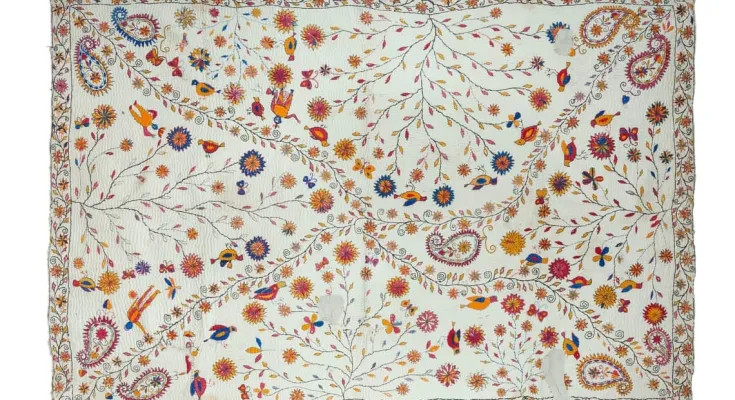There is an An online show by Museum of Art & Photography pays homage to the rich tradition of quilting in the subcontinent and its impact on modern Indian art
The desire to mend, repair and reuse is intrinsic to human nature, though that may be hard to believe in this age of disposable living. Archaeologists have found needles among the ruins of the Harappan civilisation, a discovery that imbues the familiar act of sewing with an aura of distinction. The ongoing online exhibition, Painted Stitches, Woven Stories, organised by the Museum of Art & Photography (MAP), headquartered in Bengaluru, intends to draw our attention to the alchemy of thread and needle, the poetry spawned by their conjunction, and the layers of memory and meaning these seemingly everyday materials can produce.
True to its name, the show pays homage to the rich traditions of quilting and narrative art practiced by women across the subcontinent for centuries. From the kantha makers of undivided rural Bengal to the sujni weavers of Bihar, the range of the materials on display is diverse in terms of style and geographical expanse, staggeringly beautiful and, at times, utterly eccentric and original. Curators Vaishnavi Kambadur and Arnika Ahldag have delved into the private collection of Abhishek Poddar, the founder of MAP, to put together the show, though the provenance of many of these textiles are uncertain.
“We couldn’t close these gaps [of information],” Kambadur admits on a video call, “especially since quilting was mostly (and still is) considered to be ‘women’s labour’, not given the serious attention such work deserves.” Indeed, one of the ideas behind the exhibition, Ahldag adds, “is to provoke people to look at this material with fresh eyes and ask questions about them.”
To this day, women gather in the rural parts to stitch motifs and patterns on textiles. Sometimes they copy designs given to them by their employers or work on commissions to create stunningly complex patterns. In its most basic form, though, the kantha is a utilitarian object. Old saris and discarded linen are its base materials, stitched together to form patchwork quilts. Embellishments—motifs, designs, moral or amorous messages—may be sewn onto the top layer of the quilt. Or it may be left simply bare, with fading and fraying cloth fragments joined together to create a synergy of shapes and colour. Ostensibly, the real purpose of making a kantha is to upcycle fabrics, but there is a deeper magic to the process, too.

When you cover your bed, or yourself, with a kantha made out of discarded clothes once worn by a loved one, you draw in the tenderness and warmth of a bond of affection. The material becomes a repository of memories, associated with people you know, or love, whose clothes have come together to protect you from the elements. Although MAP has an in-house restoration wing, most of the quilts in the collection have not been mended, apart from basic cosmetic repairs. The value of a kantha magnifies with the passage of time, even if that means allowing it to endure some wear and tear due to natural processes.
The handmade quilt also acts a canvas for depicting other kinds of memory—be it folkloric, mythical, or simply spun out of individual whimsy and imagination. From flora and fauna to specific scenes from the epics and village life, memories of Partition and life in exile, every detail of the past and present can be turned into grist for the kantha-maker’s mill. The show represents this variety, from a kantha with kalka patterns, typical to Bengal, with an asymmetrical design, to one that has shoals of fish swimming among colourful leaves. A profusion of stitching techniques, using a variety of threads, add depth and originality to these compositions.
Considering the breathtaking dexterity of the women who make kanthas, it was only to be expected that their handiwork would leave a deep impression on Indian artists across generations. Artists like Meera Mukherjee commissioned kantha makers from Bengal to work on intricate realist scenes of their daily lives in the 1980s. Many of Arpita Singh’s canvases have kantha stitch-like marks crisscrossing through, an influence the artist imbibed during her tenure as a textile designer. More recently, contemporary artists like Shreyasi Chatterjee and Bhasha Charabarti have used thread and needle on canvas and textiles respectively to create evocative work, especially pertaining to women’s lives.

A kantha made by the maker ‘kalachand’ depicting scenes of daily life made in the 1980s under the guidance of Meera Mukherjee. (MAP)
Yet, even as the world becomes increasingly alert to the richness of what is still seen as an artisanal tradition (though major auction houses now regularly have heirloom textiles and tapestries in their lots), the original creators, inheritors and preservers of these quilting traditions are far from getting their dues. Let alone any acknowledgement of their name on the work they make, most of these women are not even given basic minimum wages for their labour, partly due to the informal and unorganised nature of their work and partly due to the snobbery of the art-historical and commercial establishments.
Until the latter shift their focus from redundant debates on the merit of ‘art’ versus ‘craft’, the invisibility of the subcontinent’s quilt makers is unlikely to diminish. MAP’s current effort is a step towards not only making the creations of these invisible women widely visible but also the labour that goes into bringing these objects to life.
Painted Stitches, Woven Stories can be viewed on map-india.org
Source https://lifestyle.livemint.com/how-to-lounge/art-culture/those-invisible-women-who-labour-over-kantha-quilts-111618933950316.html
Titled – Those invisible women who labour over kantha quilts
By Somak Ghoshal
LAST UPDATED 21.04.2021 | 10:21 AM IST

